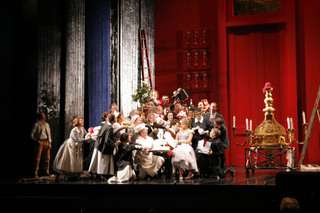|
Back
A Charming Classic Comedy Los Angeles
Dorothy Chandler Pavilion
09/26/2010 - and September 30, October 3, 6, 10, 14, 17, 2010
Wolfgang Amadeus Mozart: Le nozze di Figaro
Daniel Okulitch (Figaro), Marlis Petersen*/Rebekah Camm (Susanna), Bo Skovhus (Count Almaviva), Martina Serafin (Countess Almaviva), Renata Pokupić (Cherubino), Ronnita Nicole Miller*/Tracy Cox (Marcellina), Alessandro Guerzoni (Doctor Bartolo), Christopher Gillett (Don Basilio), Valentina Fleer*/Janai Brugger-Orman (Barbarina), Philip Cokorinos (Antonio), Daniel Montenegro (Don Curzio), Rebecca Tomlinson (Bridesmaid), Helene Quintana (Bridesmaid)
Grant Gershon (Associate Conductor/Los Angeles Opera Chorus Master), Plácido Domingo*/Israel Gursky (Conductor)
Ian Judge (Director), Tim Goodchild (Scenery Designer), Deirdre Clancy (Costume Designer), Mark Doubleday (Lighting Designer), Sergio Trujillo (Original Choreographer), Chad Everett Allen (Associate Choreographer)

(© Robert Millard)
To understand the genesis of Le nozze di Figaro one must turn back the clock to the late 18th century, a period of social and political unrest on two sides of the Atlantic. Sitting in the midst of these tumultuous times was a man by the name of Pierre-Augustin Caron de Beaumarchais. Although learning the trade as a watchmaker at the age of thirteen under the tutelage of his father, Beaumarchais’ name became more closely associated with other professions such as inventor, musician, arms dealer, diplomat and even revolutionary. But Beaumarchais was best known for his play writing, and a stage comedy in particular, La Folle journée, ou Le Mariage de Figaro. Despite the play being banned initially in 1784 largely due to its satire on the aristocracy and predating the French Revolution, the prescient Wolfgang Amadeus Mozart had visions of turning Figaro into an opera buffa with the aid of his librettist Lorenzo da Ponte. Indeed, he did. Le nozze di Figaro became an instant success on the opening night of May 1, 1786 in Vienna.
Now we turn the clock forward: a mere three days ago General Director Plácido Domingo was on stage for the exciting World Premiere of Daniel Catán’s Il postino
(Read here). Today he moves to the orchestra pit to conduct Le nozze di Figaro in this delightful 2004/2006 revival reproduction under the direction of Ian Judge. Los Angeles Opera can also claim an entourage of international stars, several of whom make their first time appearance at The Dorothy Chandler Pavilion.
Canadian born Daniel Okulitch returns in the title role after making his earlier debut as Seth Brundle in Howard Shore’s The Fly. This bass-baritone has the prowess of combining acting and singing into a satisfying sum as the vengeful Figaro who aims to marry the Countess’ maid. Reminiscent of Tom Hulse from the movie, Amadeus, Okulitch pleasingly brings his character to life by maneuvering though the roller coaster of events. Of particular note is his acerbic temperament displayed during the biting aria, “Aprite un po’ quegli occhi” in Act IV.
Marlis Petersen, who in recent months has garnered attention as Berg’s Lulu and Thomas’ Ophélie at The Met, is perfectly matched as Susanna, using her whimsical vocal flair and taunting personality to get her Figaro in the end. Paired alongside Petersen is Martina Serafin in the role as the Countess. Serafin’s voice is consistently strong and assured, and she makes good use of her emotions especially during “Dove sono” with an anguished yearning for renewed love. Her tessitura is well matched for this part.
Denmark should be rightfully proud of their own Bo Skovhus as the unrelenting Count Almaviva in an attempt to finagle his way to Susanna. Combined with a commanding and dominating baritone voice, Skovhus’ brawny good looks and muscular physique make him an imposing lord of his own castle. Of particular note is the unabashed rage he unleashes in the Act III recitative and aria, “Hai già vinta.”
Equally amusing is the returning Ronnita Nicole Miller in the role of Marcellina. She executes the singing and acting in a conservative manner that compliments the other characters on stage. Alessandro Guerzoni’s own Doctor Bartolo does an acceptable job as Figaro’s long lost father, but at times he struggles with the lowest notes in his register that virtually become inaudible. His teaming up with Don Basilio is humorous enough, and Christopher Gillett adds a nice touch of suggestive naughtiness to the character.
One of the impish threads to weave in and out of Le nozze di Figaro is the escapades of Cherubino, presented by Croatian mezzo-soprano Renata Pokupić. Similar to Serafin and Skovhus, Pokupić also makes her debut at Los Angeles Opera. Her stature and gesticulations are conveyed in a delightfully simple fashion that never go overboard while delivering a pleasing rendition of her famous aria “Non so più” in Act I. Because of her love for all women, she is eventually matched with Antonio’s daughter Barbarina. Although a very minor role, Valentina Fleer’s singing is silky and creamy and soothing to the ear; hence, she makes a splendid Barbarina. Likewise, Philip Cokorinos’ portrayal as the argumentative gardener is handled well.
Because of the success of two previous Le nozze di Figaro productions in recent years, we welcome the chance to have the combined artistic visions of Ian Judge as Director and Tim Goodchild as Scenery Designer. When originally viewing the production, one assumes the time period to be that of the late 18th century; however, several little props (i.e. telephones, high heeled shoes and flashlights) make us think twice. Indeed a juxtaposition, yet this is precisely Judge’s point: to make a timeless Le nozze di Figaro. Perhaps this is why many of Mozart’s operas have been so successful century upon century due to its universality.
Landing the right singers for Le nozze di Figaro is crucial. Los Angeles Opera is fortunate to have so many artists on and off stage to make this one of the most entertaining comedies on the operatic stage. If you want or need a chuckle or two, then don’t miss this Le nozze di Figaro. The Dorothy Chandler Pavilion is the place to be!
Christie Grimstad
|